Coconut Spiders: 10 Strange but True Facts about Coconut Crabs
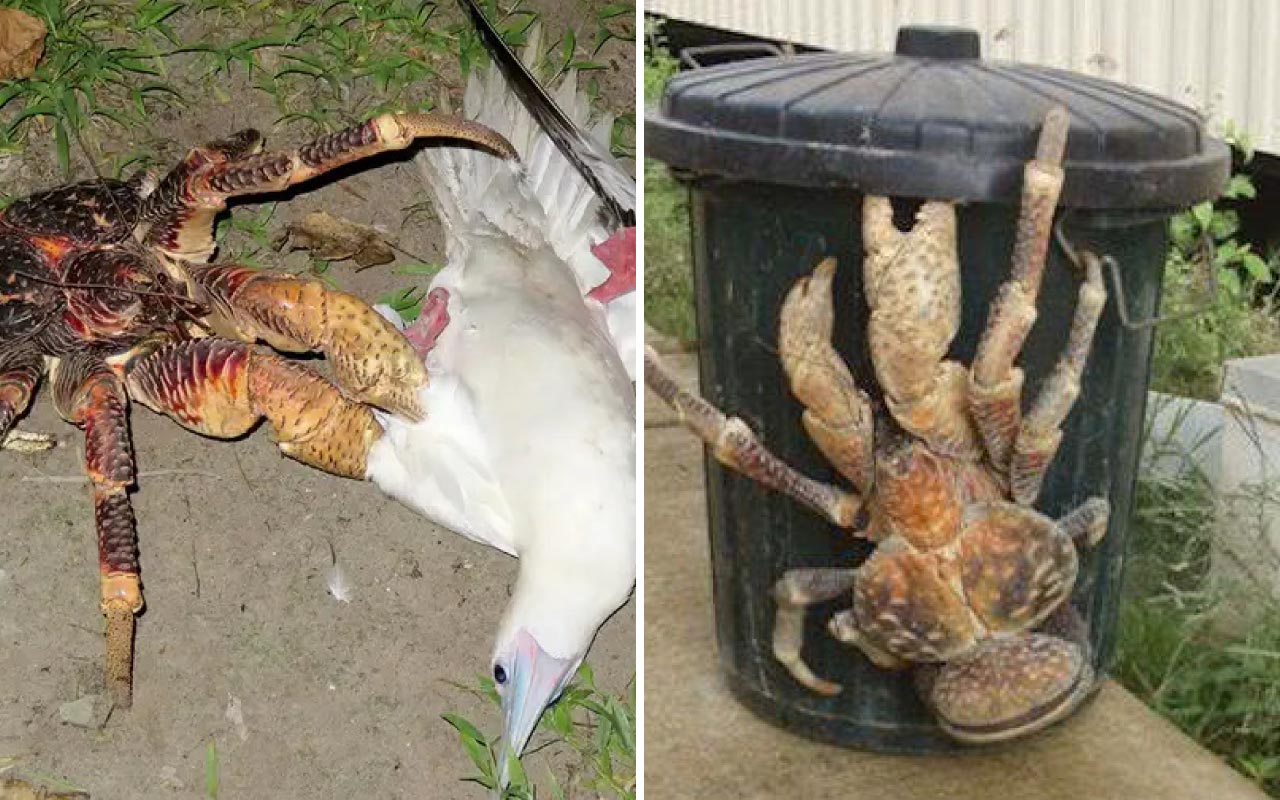
Hey there, nature lovers! Prepare to enter the captivating world of coconut crabs, nature’s giant clawed marvels. Consider a creature with massive claws and the tenacity of a seasoned mountaineer when it comes to climbing trees.
Yes, that’s a coconut crab, and I’m here to take you on an exciting adventure into their fascinating world.
Coconut crabs, also known scientifically as Birgus latro, are truly one-of-a-kind. These magnificent creatures, which can be found in coastal areas and on islands throughout the Indo-Pacific region, are known for their enormous size and weight. They are, in fact, the world’s largest land-dwelling arthropods. Now that’s quite a feat!
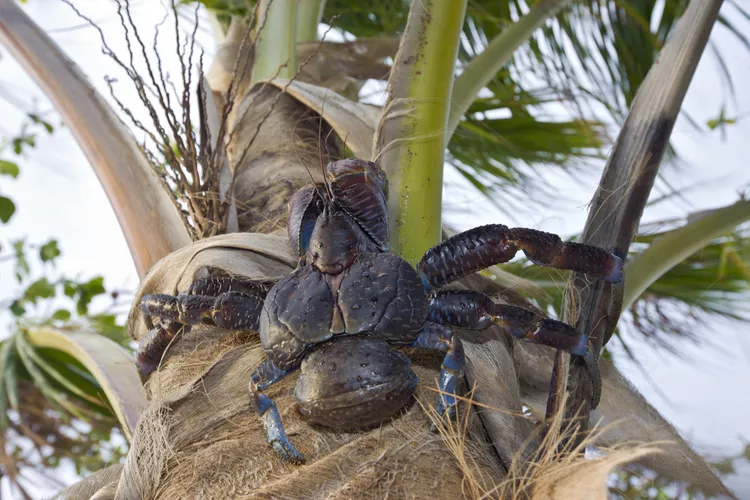
These impressive creatures have a unique set of characteristics that make them stand out from the crowd. Their powerful claws, capable of exerting incredible force, allow them to easily crack open coconuts, hence their name.
They are not only skilled at scavenging fallen coconuts, but they also eat a varied diet of fruits, carrion, and even small animals.
So buckle up and join me on this adventure to discover more about the fascinating world of coconut crabs. We’ll explore their life cycle, their unique abilities, and even conservation efforts to protect these incredible creatures.
Understanding Coconut Crabs
Coconut crabs are among the most fascinating creatures in the natural world. Allow me to introduce you to these incredible creatures and shed some light on their distinguishing features.
What are Coconut Crabs?
Coconut crabs, scientifically known as Birgus latro, are a type of land arthropod in the hermit crab family. But don’t be fooled by the name; they’re much bigger and more intimidating than their hermit crab cousins.
These fascinating creatures can grow to incredible sizes, making them the largest land-dwelling arthropods on the planet.
Coconut crabs can be found in the Indo-Pacific region’s coastal areas and islands. Their name is derived from their extraordinary ability to crack open coconuts with their powerful claws.
They can exert incredible force with their massive pincers, allowing them to access the tasty contents of fallen coconuts.
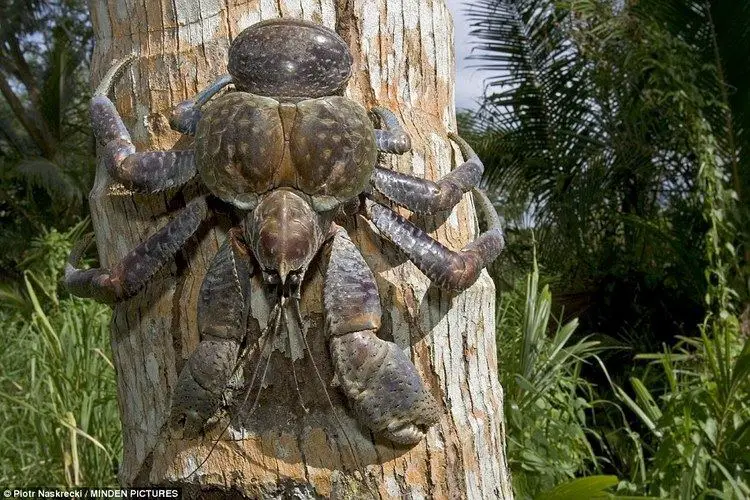
Distribution and Habitat
Coconut crabs live in a variety of Indo-Pacific regions, including the Andaman Islands, Christmas Island, and the Seychelles.
These areas provide ideal conditions for these amazing creatures to thrive. They prefer coastal areas and islands with land and sea access, where they can find plenty of food and suitable nesting grounds.
Anatomy and Physical Features
Prepare to be astounded by the size of coconut crabs. These amazing creatures can grow to be more than 3 feet long and weigh up to 9 pounds! They are a sight to behold due to their enormous size.
Coconut crabs’ powerful claws are one of their most notable characteristics. These powerful pincers enable them to open not only coconuts but also a variety of other fruits and hard-shelled animals. They can easily crush through tough exteriors due to their exceptional grip strength.
Coconut crabs have a strong exoskeleton that protects and supports them in addition to their powerful claws. This hard outer shell protects their vulnerable body parts and aids in moisture retention in their terrestrial habitat.
Check out the following video for a closer look at the incredible anatomy and physical features of coconut crabs. You’ll get a better understanding of their remarkable adaptations after seeing their massive claws in action.
Coconut crabs are undoubtedly nature’s giants, captivating us with their enormous size, powerful claws, and one-of-a-kind adaptations.
Life Cycle and Behavior of Coconut Crabs
In this section, we’ll delve into their fascinating life cycle and behavior, revealing the secrets behind their reproductive process, feeding habits, and social interactions.
Reproduction and Growth
Let’s start with the reproductive journey of coconut crabs. External fertilization is a process that these amazing creatures engage in.
During mating season, male coconut crabs seek out females and engage in courtship rituals such as drumming their pincers against the ground to attract a mate.
When a female is fertilized, she carries the eggs beneath her abdomen until they hatch. The eggs then go through a fascinating transformation, progressing through various developmental stages until they emerge as tiny coconut crab larvae.
These larvae eventually make their way to the sea, where they continue to grow and develop before returning to land as juvenile coconut crabs.
Feeding Habits and Diet
Coconut crabs are opportunistic feeders with a varied diet. While their name implies a preference for coconuts, their culinary interests extend far beyond that.
Fruits, fallen nuts, carrion, and even small animals are on the menu for these omnivorous creatures.
Their ability to crack open coconuts demonstrates their immense strength. They can easily crush through the tough outer husk of a coconut with their powerful claws, revealing the delicious contents inside. It’s quite a sight to behold!
Want to see these deft feeders in action? Check out the following video to witness their impressive feeding behavior and marvel at their distinct dietary preferences.
Territoriality and Social Interactions
Coconut crabs are known for their territorial nature. They establish and defend their territories, especially during the breeding season. These territories provide shelter as well as food for the crabs.
When it comes to social interactions, coconut crabs exhibit a mix of aggression and cooperation. They may engage in dominance displays and territorial fights with conspecifics, especially during mating encounters.
When resources are abundant, they can tolerate the presence of other coconut crabs in close proximity.
Coconut crabs may interact with other animals in their environment, in addition to their own kind. This can include encounters with scavengers, predators, and potential food sources.
Coconut crabs continue to captivate us with their unique life cycle, diverse feeding habits, and complex social interactions.
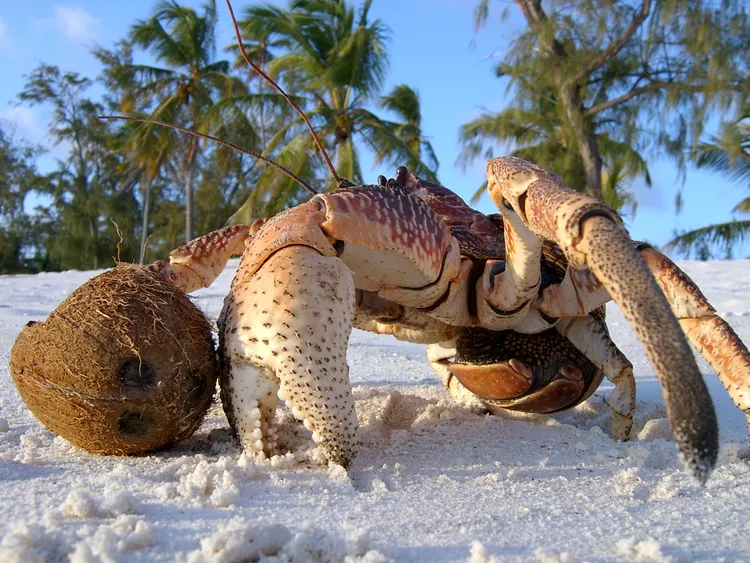
Impressive Abilities of Coconut Crabs
Welcome back to our journey through the fascinating world of coconut crabs! In this section, we’ll look at the extraordinary abilities that distinguish these creatures.
Coconut crabs continue to astound us with their climbing abilities and sense of smell, as well as their regenerative abilities and self-defense mechanisms.
Climbing Skills and Adaptations
Coconut crabs are well-known for their incredible climbing abilities. They move through trees with agility and precision, despite their large size and weight.
Their powerful claws, which are specially adapted for climbing, allow them to grip tree trunks and branches and ascend to impressive heights.
Coconut crabs have specialized adaptations that help them climb. They have powerful legs that give them the necessary strength and stability.
Their exoskeleton is flexible, allowing them to move quickly, and their elongated abdomen aids in balance during tree-climbing expeditions.
Sense of Smell and Orientation
Coconut crabs have an exceptional sense of smell, which is critical to their survival. They have highly developed olfactory receptors that allow them to detect scents from great distances.
This acute sense of smell aids them in locating potential food sources and navigating their surroundings with accuracy.
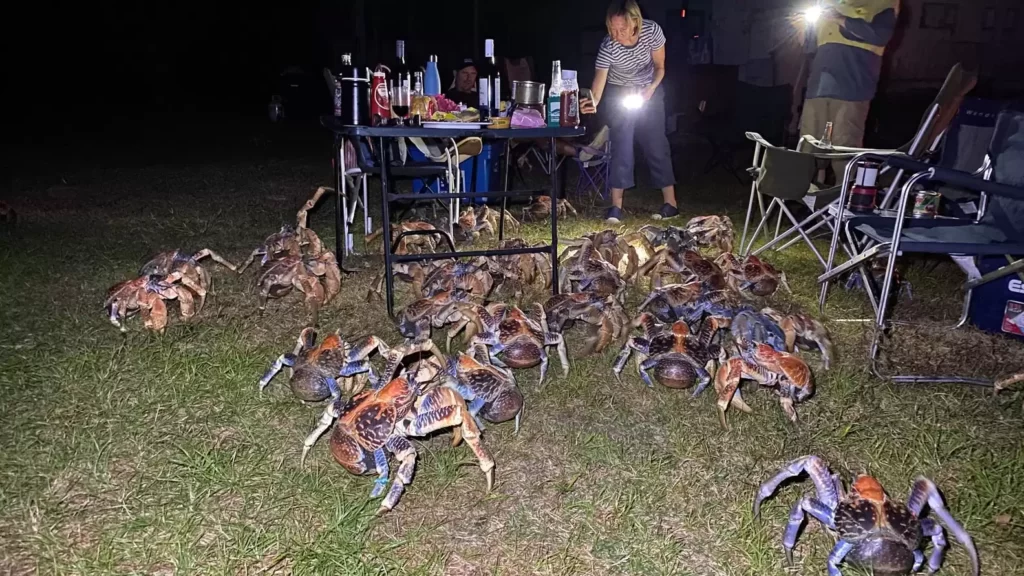
Check out the following video for a closer look at how coconut crabs use their sense of smell to find food and navigate their environment. Discover the amazing abilities of coconut crabs as they use their noses to find delicious meals and navigate their environment.
Coconut crabs can find food quickly because of their ability to detect the scent of food from a long distance. They can quickly track down their next meal, whether it’s the aroma of ripe fruits, decaying carcasses, or other enticing morsels.
Regeneration and Self-Defense Mechanisms
Coconut crabs have remarkable regenerative abilities, which allow them to recover from injuries and replace lost body parts.
If a claw is damaged or severed, the crab will eventually regenerate a new one. This remarkable ability ensures their continued survival in the difficult and sometimes hostile environments in which they live.
Coconut crabs have developed effective mechanisms for self-defense. Their powerful claws can be used both offensively and defensively, allowing them to repel potential threats.
When threatened, they can deliver powerful pinches with their claws, deterring predators and protecting themselves.
Additionally, coconut crabs use hiding behaviors to avoid danger. They hide in crevices, burrows, or other sheltered areas, blending in with their surroundings thanks to their adaptive coloration.
This camouflage aids in their concealment and increases their chances of survival.
Coconut crabs have a wide range of impressive abilities. They have evolved to thrive in their unique environment, from their incredible climbing abilities and acute sense of smell to their regenerative abilities and self-defense mechanisms.
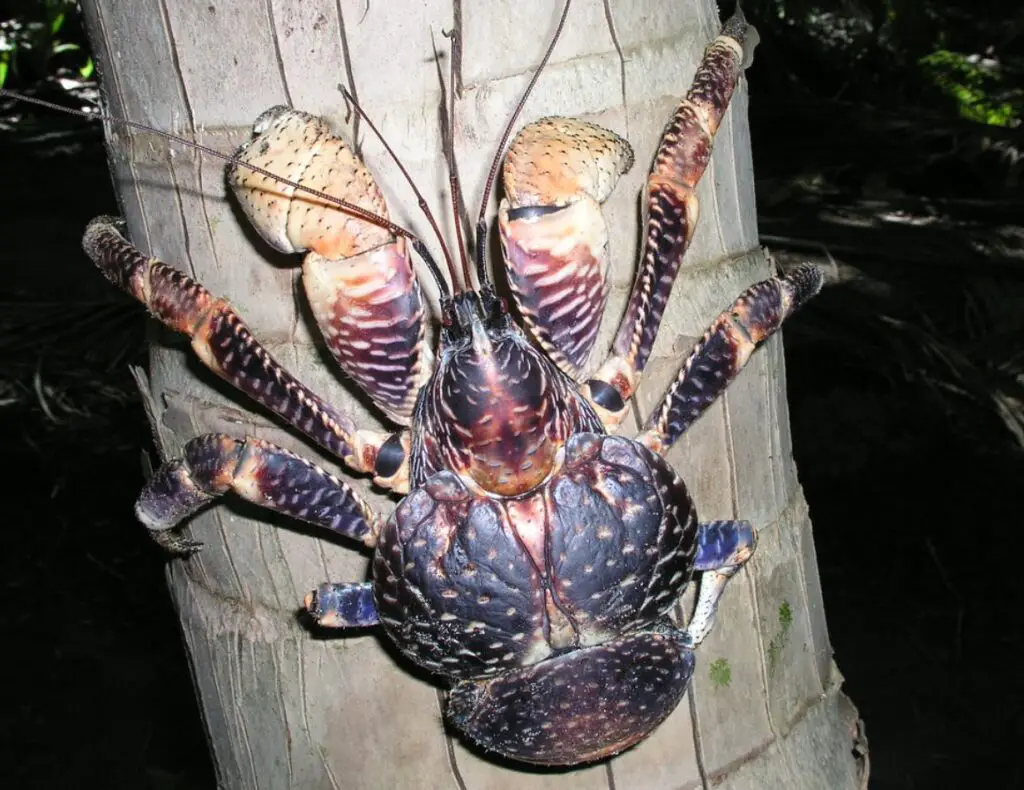
Here are 10 strange facts about coconut crabs:
#1. Coconut crabs are the world’s largest land-living arthropod, with some reaching 3 feet in length and weighing up to 9 pounds.
#2. Their name comes from their extraordinarily strong claws, which can split whole coconuts.
#3. They have also been recorded climbing trees and reaching heights of up to 40 feet in search of food.
#4. Coconut crabs are nocturnal, meaning they are most active at night.
#5. They are also known to be aggressive, defending their area from other coconut crabs.
#6. They are also cannibalistic, eating other coconut crabs if food is scarce.
#7. Coconut crabs have a life span of up to 60 years.
#8. They are also known to be highly intelligent, with some studies indicating that they can plan ahead of time and use tools.
#9. In some regions of the world, they are considered a delicacy and are frequently used in traditional dishes.
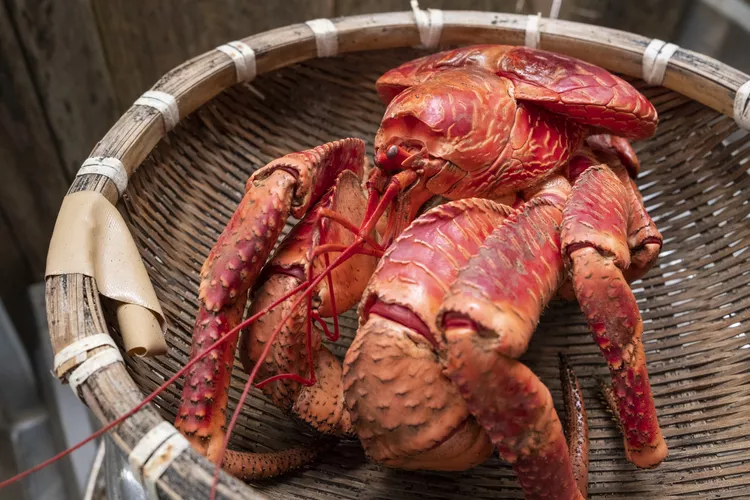
IMAGE: Tsuneo Yamashita / Getty Images
#10. Coconut crabs are considered a vulnerable species and are protected by legislation in various countries due to over hunting and habitat degradation.
Australia is home to many weird animal creatures. The World’s scariest animals can be seen in Australia. If you are more curious about the animals, Here are 22 Most Weird Australian Animals.
Conservation and Human Interaction
As we come to the end of our investigation into coconut crabs, it’s important to address the pressing issue of conservation and the interactions between these fascinating creatures and humans.
We’ll look at the threats and challenges that coconut crabs face, as well as the ongoing efforts to protect them and promote sustainable practices, in this section.
Threats and Challenges
Coconut crabs are threatened by a number of factors that endanger their population and long-term survival. Human-caused habitat loss, such as coastal development, deforestation, and pollution, is one of the primary concerns.
The destruction of their natural habitat disrupts their nesting sites and reduces the availability of food sources, affecting the population as a whole.
Additionally, the illegal harvesting and trade of coconut crabs for food, as well as the exotic pet market, pose significant challenges.
Over-exploitation of these creatures can result in a decrease in their numbers and a disruption of their ecosystem’s delicate balance.
Conservation Efforts
Fortunately, many people and organizations are working tirelessly to protect and conserve coconut crabs.
Ongoing initiatives aim to raise awareness about the importance of these unique creatures while also putting measures in place to ensure their survival.
Conservation efforts include the establishment of protected areas and marine reserves where coconut crabs can thrive in peace.
These protected areas serve as safe havens for their nesting grounds and as a refuge for their continued survival.
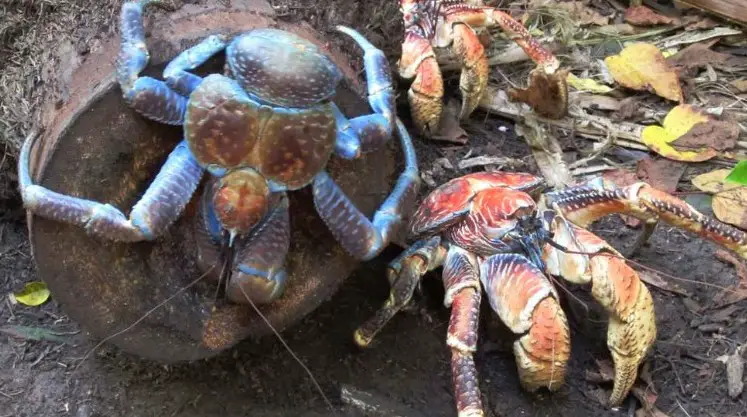
Aside from protected areas, it is critical to educate local communities, tourists, and individuals about the importance of environmentally friendly practices.
Promoting responsible tourism and advocating for the conservation of coconut crab habitats can help to save these incredible creatures and their fragile ecosystem.
We can ensure a brighter future for coconut crabs and help maintain the delicate balance of our natural world by supporting conservation efforts, raising awareness, and promoting sustainable practices.
Their number, however, is declining due to habitat degradation and over-exploitation. To keep the population constant, it is critical to conserve the environment of these wonderful species while also limiting hunting pressure.



